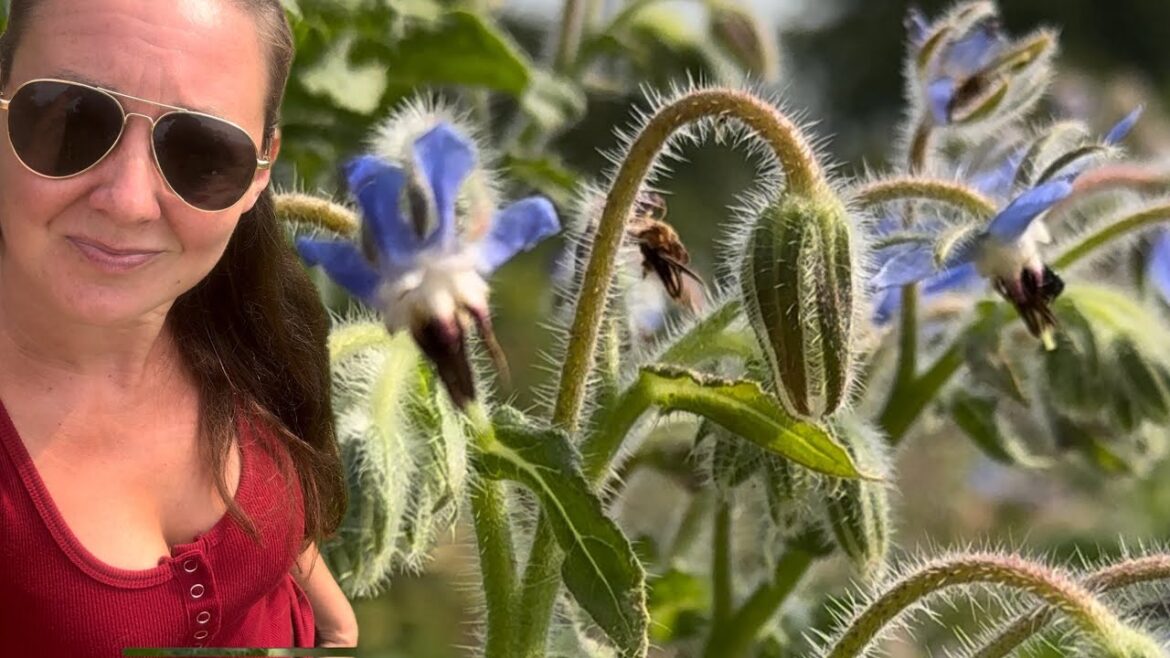EVERY GARDEN NEEDS BORAGE //
Let’s talk about another permaculture powerhouse plant that’s actually in the same family as comfrey. It’s borage and, hopefully, after reading below, you’ll add it to your growing space too. 🤗
🌱 Similar to comfrey, BORAGE has a taproot. It mines and releases nutrients, especially potassium and calcium. This makes it an AWESOME companion for tomatoes and squash crops. A soil deficiency in these can be what causes blossom end rot.
🌱 BORAGE is like chamomile in that if you sow it once, it’ll reseed itself every year. It’s an annual but comes back with vigor. While not technically invasive, it can be hard to eradicate if you change your mind later. So plant with permanence in mind. I view this as a perk—less work for me.
🌱 BORAGE isn’t just a nutrient accumulator, it’s also a mulcher. Chop and drop the leaves as garden mulch. It’ll release the nutrients it contains back into the top layers of the soil as it decays. This helps other plants.
🌱 It’s said cabbage worms and horn worms HATE BORAGE. Rabbits and deer also dislike it!
🌱This plant is a pollinator magnet. Honeybees, native bees, beneficial wasps, etc LOVE BORAGE. Plant next to cucumber to increase your veggie yields.
🌱 Speaking of pollinators, BORAGE flowers are unique. They refill their nectar in just minutes, making this an incredible food source.
🌱You can actually grow this as a cover crop. Cut and let decay in place in areas where you’d like to improve soil.
🌱 Fertilize your garden with BORAGE TEA. Chop the leaves and soak in 1 part BORAGE to 10 parts water. Steep 24 hours, with a bubbler if you have one, and water your garden.
🌱 Thanks to all its nutrients, BORAGE is a compost activator. Toss in your heap to get the good microbes going!
🌱 BORAGE flowers are edible for humans!
🌱 There are said to be loads of medicinal benefits of BORAGE. If you’re into the home apothecary, this may help an excellent plant to research.
#permaculture #permaculturefarm #permaculturelife #organicgardening #organicfarming #ediblegardening #borage #companionplanting #homestead #homesteading #sustainable
////////////
My Books:
The Sustainable Homestead: https://a.co/d/aJiktEc
The Little Homesteader, Spring: https://a.co/d/81clkYB
The Little Homesteader, Summer: https://a.co/d/1Dcqgvx
The Little Homesteader, Fall: https://a.co/d/4NVXWcO
The Little Homesteader, Winter: https://a.co/d/hpQ8x7s
The Harvest Table Cookbook: https://a.co/d/00rW3uq
/////////////
Welcome to Axe & Root Homestead®! I’m a first generation, self-taught permaculture farmer in Central New Jersey. If you’re looking for information on gardening, homesteading, canning, animal care, working with your land, or regenerative farming practices, I have lots of info to share:
Instagram: https://www.instagram.com/axeandroothomestead/
Blog: https://www.axeandroothomestead.com/blog
Podcast: https://podcasts.apple.com/us/podcast/homesteaducation/id1593301801


4 Comments
Very useful, thank you for sharing such valuable info about borage/starflower ^^
It looks like Comfrey a lot. What is best in your opinion? Borage or Comfrey? I have comfrey seeds but havent decided whether i should plant it or not. Heard some bad stuff about it.
My rabbits love to eat borage, I don't think it's going to detract rabbits. It's edible to them. They hate alliums.
I've heard that it is fairly easy to grow but I haven't been successful starting borage from seed. Any tips?